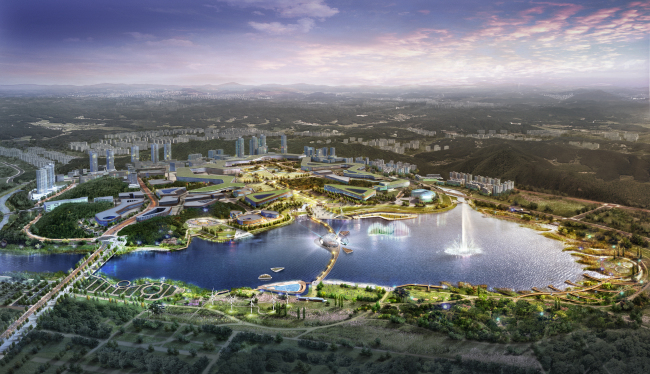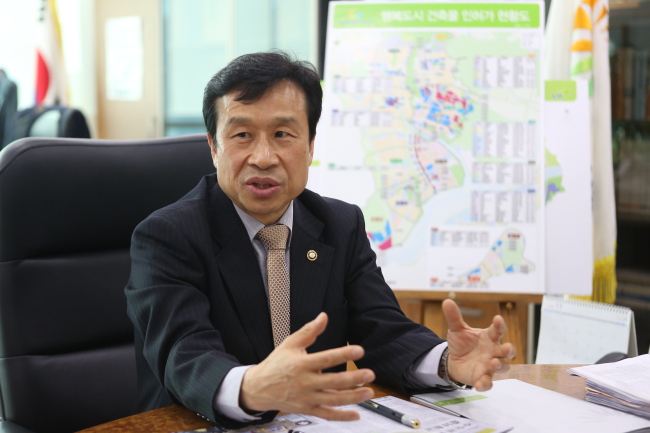The controversial Sejong City is neither a needless extension of Seoul nor a dispersion of its administrative functions, but rather a golden opportunity to strategically create an ideal future-oriented city, according to the chief conductor of the project.
Lee Choong-jae is the chairman of the Multifunctional Administrative City Construction Agency, the special organization in charge of mapping out the development of the new Sejong government complex and its surrounding area.
“Sejong City, with seven multi-functions including administration, education and business, will become a whole new city that may stand equal to Seoul in the near future,” Lee told The Korea Herald in an interview.
“Seoul doesn’t have much room for further growth considering its density. For further growth of the nation, we need another city, which may (also) diversify our color in the global community.”
Sejong should, therefore, not be regarded as a far-off subordinate city to Seoul but as a powerful new player on the chessboard, while Seoul continues its own evolution as the capital city, he continued.
This is why it is important that the new city be located away from Seoul and the metropolitan area, despite some people’s complaints, he explained.
“Korea has been heavily reliant on its capital area, while its provincial cities have long remained disconnected from one another,” the official said.
Seeking balanced development of land, the government relocated some of its administrative functions to Gwacheon, Gyeonggi Province, in the 1980s, and moved some of its public organizations to more distant provinces in the 1970s.
“But such processes were mere geographical dispersion, as there was no junction to connect the remote departments and institutions,” Lee said.
“Once Sejong administrative city turns out as planned, all the surrounding regions will find a connection, not only with Sejong but with all the rest of the country.”
Many think of Sejong as an out-of-nowhere project but, in fact, the area has long been prepared to house a large-scale multifunctional city, the city planner also claimed.
“Ever since the 1960s, the current Sejong site has been surrounded by a network of key highways and railroads, as well as large dams such as Daecheong Dam.”
Sejong was therefore one of the very few underdeveloped areas with the potential to be developed into an ideal future city, Lee said.
“All throughout history, cities have been hindered by environmental pollution, residential supply-demand imbalances, and traffic congestion, which altogether degraded the general quality of life,” he said.
“But Sejong City, unlike conventional cities, is to be built upon a strategic blueprint and will be able to express a new urban paradigm.”
For example, all the key functions of the city, such as the administrative complex and education centers, are to be arranged in a ring format, surrounding a central green space.
“We have learned from history that a centralized city will eventually face urban saturation,” Lee explained.
The city, when completed, will be divided into six major sections: culture, commercial space, administration, research and development, medical service and high-tech industrial complexes.
Residents will not only have free access to the vast green space, which will comprise as much as 53 percent of the entire city, but also be able to reach any part of the city, either through an outer ring road or an interlacing downtown road network.
“Such efficiency would not have been plausible if not for governmental involvement and planning,” the official said.
It is true that the early-stage residents are experiencing some inconveniences due to the lack of facilities, especially in terms of commercial, cultural and educational sectors, he admitted.
“But it is still too early to make any judgments, as the entire project is only at 30 percent of development,” he said.
From next year, a total of 25 schools will be available, all of which will be equipped with smart education systems, and a soaring number of young married couples are moving to the Sejong vicinity to seek a better educational environment for their children, according to the official.
“Despite ongoing concerns about Sejong City, we are well aware that creating a key functional city for a country is not just about building its hardware but also about establishing its software,” Lee said.
“We are convinced that Sejong will become a model city, suggesting new alternatives in urban development.”
By Bae Hyun-jung (
tellme@heraldcorp.com)









